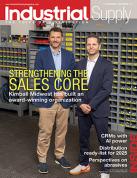Standard cost can bring extraordinary returns
by Jason Bader, The Distribution Team

When many of us set up our item databases, we were baffled at the number of fields available for capturing the price that we paid our suppliers for a particular item. We have a base cost, a list cost, a last cost, a moving average cost, a standard cost, and a just in case we need another field cost.
Most of us use only a couple of these fields, primarily the base cost and moving average cost. The moving average cost is typically what we use to calculate sales commissions off of, so it is the sacred cow of the costing world.
Having said all that, I want to introduce a little known field that can generate phenomenal net profit gains. How often do you hear the words cost and gain in the same context? I am referring to the "Standard Cost Field."
The beauty of standard cost is that it can be whatever you want it to be. It is a rather meaningless field until you assign meaning to it. It also happens to be a cost field that can be used to determine gross profit margin; or better yet, sales commissions.
I will show you how this works later; but first, let's go over the justification for changing the way we show gross profit. A word of caution, calculating gross profit based on Standard Cost is for internal reporting only. The IRS will not smile on you if this is what you use to file your income taxes. That being said, let's move on to the power of the standard cost field.
Adopting a standard cost, or landed cost, will take a little internal selling. The primary sales pitch will be to the sales staff. In standard costing, you add a small fixed percentage to the moving average cost of a product.
In my former company, we chose to add a flat 3 percent across the board. Why 3 percent? It was more than 2 percent and sounded good at the time.
Many companies justify a move to this type of costing as a way to recoup their losses due to theft, inventory carrying costs and bad debt. Think of standard costing as setting up a rainy day fund internally. You can use it when you have to expedite purchase orders because we screwed up and need some in a hurry. You can use it to offset some special deal made to lure in a new customer. It is a small pool of cash that can actually hit your bottom line if you don't use it along the way.
Again, picking the numbers is the easy part. Selling it to the sales staff is the tougher road. If you are successful, they will actually make more money in the long run.
In every business, there seems to be a magic gross profit margin number. In the eyes of some salespeople, when you cross the imaginary line, you are gouging the customer. Your salespeople, who you raised from the warehouse floor, will actually turn on you to protect their customer.
In my former business, the magic number was 35 percent. Even when we made a couple of points on a special buy, the gains went directly to the customer.
Traditional gross margin percentage for my industry was between 32 percent and 33 percent. Here is what we experienced when we implemented a standard cost bump of 3 percent. In the first 30 days, our gross margins immediately dropped 3 percent; but over the course of the next 60 days, our margins actually worked their way back up to the traditional 32 percent to 33 percent.
They actually moved past this due to the hiring of a pricing matrix guru; but that is for another article. The point is: Our margins returned to traditional levels; and we realized an additional 3 percent on the cost of goods sold. Here is a little calculation to make your eyeballs drop out of your head: (Annual Cost of Goods Sold) X (Standard Cost Bump) = Really Significant Return to Bottom Line.
After speaking to a few other companies about the benefits of using standard cost, I found some other ways to implement the program. These are best practices; but there are likely a few other ways to make the program even better.
When my company went down the trail, we chose a flat percentage bump across the board because it was easy from an accounting perspective. Unfortunately, the full 3 percent became difficult to tack onto low-margin items like power tools. In order to solve this dilemma, one company chose to vary the percentage bump by product category.
For example, power tools may get a 0.5 percent bump while a traditionally higher margin item like drywall screws may get a 5 percent bump. This approach makes more sense and will be less difficult to sell to your sales staff. It does require more discipline on the financial reporting side.
Speaking of the accounting side, make sure your controller accounts for the additional income on a monthly basis. By reviewing the program monthly, you can make adjustments to achieve the maximum benefit. There really is hidden cash in your inventory; you just need to know where to look.
Here are your action steps to get started.
- Determine the percentage rate you would like to achieve by the end of the year. A modest 3 percent is realistic. I have seen as much as 5 percent in some industries.
- Sell the concept to your sales management. They will help you sell it to the rest of the sales staff.
- With the help of the sales management, apply a percentage bump to each product category. The average should work out to your original goal.
- Create the mechanics in your system to populate the standard cost field. This can be done by creating a series of auto jobs that run on a nightly basis.
- Test the results and make adjustments where necessary.
- Prepare for a slight upturn in the corners of your mouth at year end.
Jason Bader of The Distribution Team Inc. specializes in providing inventory management training, business operations consulting and technology utilization to the wholesale distribution industry. Jason brings more than 20 years of experience working in the distribution field. He can be reached at (503) 282-2333, Jason@distributionteam.com or at www.thedistributionteam.com.















